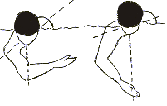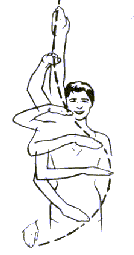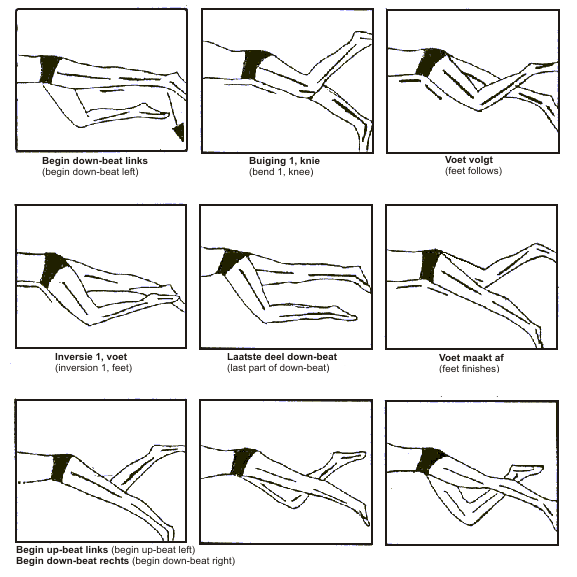Body position :
Armstroke :
Legstroke :
Remark :
|
On the breast
Double overarm-stroke
Crawlkick
The far most fastest swimming-stroke
|
Introduction
The armstroke
The legstroke
The combination
Breathing
Frequently made mistakes while swimming the frontcrawl
Introduction
The frontcrawl has a continuous armstroke and legstroke. The frontcrawl is the fastest
swimming-stroke because of:
- The body position is always horizontal,
- Little resistance during the contra-movements,
- A long damming-phase for the arms, which partly overlap eachother,
- An uneven pull-over,
- A powerful armstroke.
Because of all this, the movement is very continuous and also very efficient: with little
energy a relative high swimming speed.


The armstroke
The frontcrawl's swimming speed is caused for 70-90% by the arms. The arm movement can be
divided in a couple of phases:
- The put-in
- The gliding-phase
- The pull-phase
- The push-phase
- The lash-out
- The pull-over
1. The put-in
The put-in of the frontcrawl is straight in front of the shoulder in the line of the
shoulders or maybe a little more wider, on ¾ of the arm length with a slightly
bent elbow. The hand touches the water sooner than the elbow, which is positive for the
next phase:
2. The gliding-phase
After the put-in, the arm will be stretched to the front, at which the palm of the hand
is pointed downwards.
 During the gliding-phase the arm chooses the best position to pull through. We could say
that the hand "grabs" the water. Because the hand is searching for prop on the
water, the pull-over shoulder can be kept high and above the water, so that there is
less resistance. Also the breathing is a lot easier because of that prop.
During the gliding-phase the arm chooses the best position to pull through. We could say
that the hand "grabs" the water. Because the hand is searching for prop on the
water, the pull-over shoulder can be kept high and above the water, so that there is
less resistance. Also the breathing is a lot easier because of that prop.
3. The pull-phase
The movement of the arm right after the gliding-phase until the hand is perpendicular
under the shoulder, we call the pull-phase. During this phase there occurs a slight
bow of the elbow joint, so that at the end of this phase, the angle of the elbow joint
is about 90 degrees. Because of this, it's possible to pull through with a lot of power.
The elbow remains constantly at the highest point. During the pull-phase the palm of
the hand will be pointed backwards. The hand moves first to the side and then comes
under the shoulder again, at which a slow bow in the elbow joint occurs. At the end
of the pull-phase, the hand never passes entirely the imaginary vertical axis of the
body. When this does take place, this has direct consequenses for the body's position
in the water. The shoulder goes down under water and its position is much deeper in
the water, which causes a lot of extra resistance (see picture below).

Wrong Good
4. The push-phase
 The push-phase starts right after the pull-phase, so in the beginning the arm is
perpendicular below the shoulder until the moment that the arm, and then the hand
leaves the water.
The push-phase starts right after the pull-phase, so in the beginning the arm is
perpendicular below the shoulder until the moment that the arm, and then the hand
leaves the water.
During the push-phase the hand will go backward towards the hips and will be
slightly stretched. In fact, the hand follows a certain "S-pattern"
(looked upon from below). The elbow joint will never be entirely stretched. The
hand will make in the last part of the push-phase, just before the lash-out, a
final push backwards. This is called an uniformly accelerated movement.
The S-formed way the hand follows with regard to the body, has been drawn in
the figure on the right. With regard to the bottom the hand remains more or less
on the same depth, because the hand is "locked" in the water and the
swimmer pulls his/her body over it. The armstroke's damming surfaces are the palm
of the hand and the inner side of the forearm.
5. The lash-out
If the end of the push-phase has been executed well, the elbow will first and
the hand (starting with the little finger) will be the last to leave the water.
The lash-out takes place at the hips and/or the upper leg. During the lash-out
the hand is as close as possible to the body and partly unbended. In fact there
has to take place a smooth movement between the pull-through and the pull-over.
Because of this a shaking movement will be prevented.
6. The pull-over
The pull-over takes place with a "high" elbow and has to take place
unbended: the forearm and hand are "hanging" below the elbow. Swimming
with a "low" elbow and a "wide" movement cost more energy
and cause more unwanted rotations. All the movements should take place as close
as possible to the body's length-axis.
Because the pull-over can take place faster than the pull-through (less/no
resistance), we see that the arms with regard to eachother do not start acting
like the "wings of a mill", but make up for eachother and go away from
eachother. The complete armstroke passes away uninterupted. The shoulder also
moves continuously (also called the "rolling" of the shoulders).
The rolling of the shoulders must only take place in the length-axis of the body.


The legstroke
Although the arm-movement contributes by far the most to the swimming speed,
it is wrong to think that the legstroke is not of any significance. The arms
and legs have to cooperate precisely, to swim a well swum stroke. A good
legstroke contributes its part to the whole. The legstroke has two functions:
- A stabilizing/compensating function (most important)
- A damming function
The leg-movement consists of an alternation of up- and downbeats, at which the
legs pass eachother during the stroke. The legstroke is often very irregular
and very differ at different swimmers and takes rarely place only in a vertical
direction.
The irregularities consist of: emphasisstrokes, drag-movements and differences
in moving results. These irregularities are closely connected to the way the
armstroke is swum and the breathing. Although the up- and downbeat both have a
damming function, the effect of the downbeat is bigger, because of a more
positive position of the damming surfaces.

The movement starts from the hip, at which in the upbeat the leg will be stretched
because of the water resistance. The downbeat of the upper leg has already been
started when the feet are still moving upwards. At the turning point the unbended
foot goes down, at which the foot sole can give stowage. Meanwhile, the knee has
also been bended when the foot went down, the shinbone and instep are in a
favourable position to cause stowage in the downbeat.
This effect will be strengthened, because the upper leg moves back in upward
direction. This is only possible when the unbended leg follows the movement out
of the hips. In the end there arises a wave-alike pattern via upperleg - knee -
lower leg - ankle - foot.
Click on the picture on the right to zoom in...


The combination
There are different combinations that can be swum; for example the American crawl.
This means that in one complete armstroke, fit exactly six downbeats of the legs.
For short, we could say 2:6. Characteristics of the American crawl are: intensive
legstroke, a clear gliding-phase, the tempo of the arms relatively slow and the
pull through close to the body with high elbows. Finally we could say:
- The downbeat of the right leg equal to the put in of the left arm.
- The downbeat of the right leg equal to the link between the pull-phase
and push-phase of the left arm
- The same counts for the left leg and the right arm, of course.
At the 2:2 the armstroke is very dominant. There is no, or hardly any legstroke
present. This combination (2:2) is also called the Australian crawl, because a
lot of Australian swimmers swim this way.
Breathing
Inhaling takes place when the arms are in the extension of eachother, which
means in practice: inhaling on the left side, when the left hand is at the height
of the left hip and the right hand starts with the put-in/gliding-phase. Inhaling
takes place in the valley at the left side, at which the head turns around
the length-axis of the body. Exhaling gradually takes place under water via the
nose as well as the mouth.
Most swimmers have a favorite side to breathe and often only inhale at that
favourite side. There also are swimmers who have the ability to breath at sides.
This type of breathing is considered to be the best way. The legstroke plays a
supporting role with breathing during swimming.

Frequently made mistakes
- No or little rolling of the shoulders
- During the put-in phase, the arms cross the length-axis of the body
- The pull-through is to much sidewards
- Too much legstroke, in stead of a proper armstroke
- Hooked toes, where the ankles are not relaxed.
- The arms or not dominating but the legs do
- The position of the head: too high or too deep, which causes problems
with breathing and of course more water resistance

|


